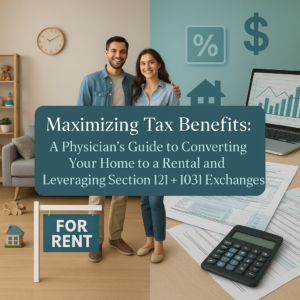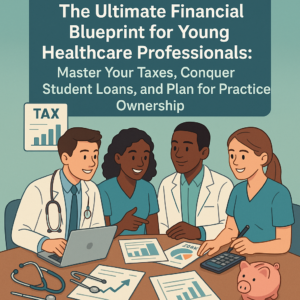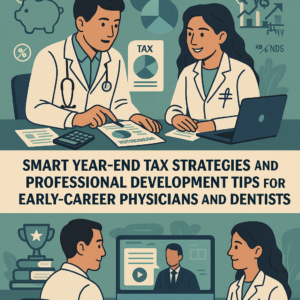Maximizing Your 401(k): Tax Strategies for After-Tax Contributions and Roth Conversions
As a young healthcare professional embarking on a promising career, you’re focused on caring for others. But are you giving the same attention to your own financial health? Understanding the tax implications of your retirement savings can make a significant difference in your future. In this comprehensive guide, we’ll explore how after-tax contributions to your 401(k) can be leveraged through Roth conversions, the nuances of the mega backdoor Roth, and strategies to optimize your retirement savings while minimizing tax liabilities.
Understanding After-Tax Contributions in Your 401(k)
First, let’s demystify after-tax contributions. Unlike pre-tax contributions, which reduce your taxable income now, after-tax contributions are made with money that’s already been taxed. This means you won’t owe taxes on these contributions when you withdraw them in retirement. However, any earnings on these contributions will be taxable unless you take strategic action.
The Benefits of After-Tax Contributions
- Higher Contribution Limits: After-tax contributions allow you to exceed the standard 401(k) contribution limits, letting you save more for retirement.
- Tax Diversification: Mixing pre-tax and after-tax contributions can provide flexibility in managing your taxable income during retirement.
- Opportunity for Roth Conversions: Converting after-tax contributions to a Roth account can result in tax-free growth and withdrawals.
What Is a Roth Conversion?
A Roth conversion involves moving funds from a traditional retirement account into a Roth account. The main advantage? Future earnings and withdrawals from the Roth account can be tax-free, provided certain conditions are met. For healthcare professionals who anticipate higher income—and potentially higher tax rates—in the future, paying taxes now on the converted amount could be beneficial.
In-Plan Roth Conversions Explained
An in-plan Roth conversion allows you to convert eligible funds within your 401(k) to a designated Roth account within the same plan. Here’s how it works:
- Eligibility: Not all 401(k) plans offer this option, so you’ll need to check with your plan administrator.
- Tax Implications: While after-tax contributions themselves aren’t taxed upon conversion, any earnings on those contributions are taxable in the year of the conversion.
- Pro-Rata Rule: The IRS requires that any conversion includes a proportional amount of taxable earnings, which can complicate tax calculations.
Example Scenario
Consider Dr. Smith, who has made $50,000 in after-tax contributions and has $5,000 in earnings on those contributions. If she converts the entire $55,000 to a Roth 401(k), she’ll owe taxes on the $5,000 of earnings.
The Mega Backdoor Roth Strategy
The mega backdoor Roth is an advanced strategy that allows high-earning individuals to contribute significant amounts to a Roth 401k, bypassing traditional income limits. Here’s how it works for healthcare professionals:
- Make After-Tax Contributions: Contribute after-tax dollars to your 401(k) beyond the standard limits.
- Perform a Roth Conversion: Roll over these after-tax contributions to a Roth, where they can grow tax-free.
Benefits and Considerations
- Maximized Savings: Allows contributions up to the total 401(k) limit ($70,000 in 2025, including employer contributions).
- Tax-Free Growth: Future earnings in the Roth won’t be taxed upon withdrawal.
- Complexity: Requires careful planning and may involve navigating plan rules and IRS regulations.
Consulting a Financial Advisor
Navigating the complexities of retirement accounts and tax laws can be challenging. A financial advisor who understands the unique needs of healthcare professionals can provide personalized guidance. They can help you:
- Analyze Your Options: Evaluate whether in-plan Roth conversions, mega backdoor Roth, or split rollovers align with your goals.
- Plan Strategically: Optimize timing and amounts of conversions to minimize tax impact.
- Stay Compliant: Ensure all actions meet IRS regulations and avoid potential penalties.
Key Takeaways
Maximizing your retirement savings involves more than just setting aside money—it’s about strategic planning and understanding the tools available to you. Here’s what we’ve covered:
- After-tax contributions to your 401(k) can open doors to significant tax advantages.
- Roth conversions allow for tax-free growth and withdrawals, benefiting future you.
- The mega backdoor Roth is a powerful strategy for high earners to bolster their retirement savings.
- Consulting with a financial advisor can tailor these strategies to your unique situation.
Conclusion
Your dedication to improving the lives of others is commendable. By taking proactive steps now to understand and optimize your retirement savings, you’re also investing in your future well-being. Consider exploring these strategies further and reach out to a financial professional who can help you make informed decisions.






